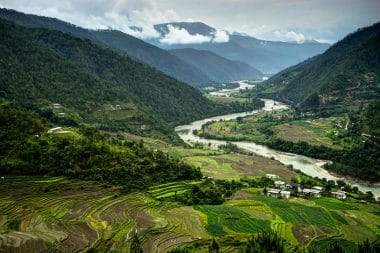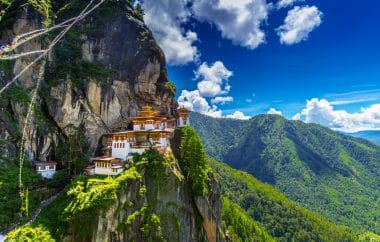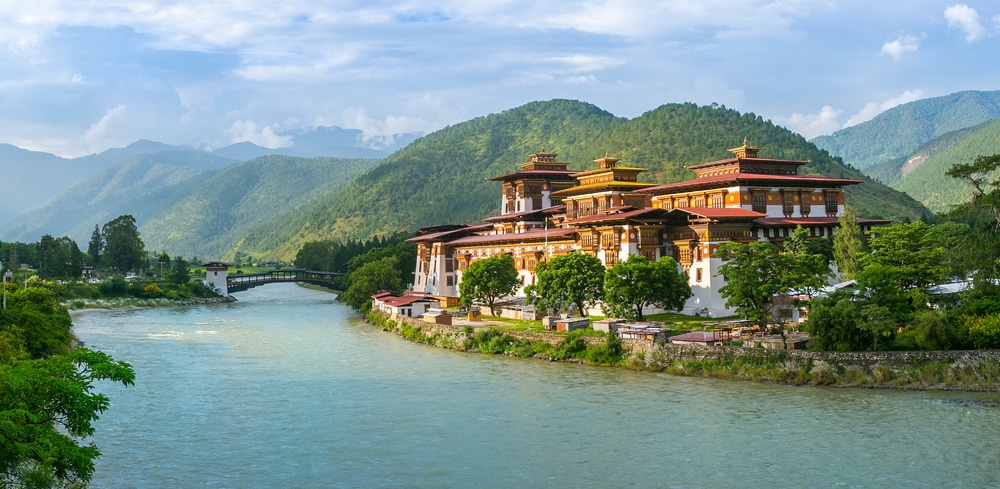A charming Buddhist kingdom in the Himalayas, that’s Bhutan! Colonialism passed this country by, because it is quite hidden between the giants China and India. Officially, Bhutan is called Druk Yul, “Land of the Thunder Dragon”. Decades ago, “gross national happiness” was declared the highest state goal. This is not only about material prosperity, but also about contentment and spiritual harmony with the world.
The head of state is the young “Dragon King” Jigme Khesar Namgyel Wangchuck. His father voluntarily limited royal power in favor of parliament. The country is slightly smaller than Switzerland, but has only about 740,000 inhabitants. Almost 80,000 people live in the capital Thimphu, all other settlements are much smaller. Here, perhaps, if you are “lucky”, you can see a traffic jam and set pieces of today’s globalized world. In many other places, however, Bhutan seems to have fallen out of time.
72 percent of the population follow the state religion, Mahayana Buddhism. This manifests itself in various forms that are close to Tibetan Buddhism. 27 percent are Hindus. They live mainly in the southern lowlands, mostly have Nepalese roots and are less highly respected.
Nature in Bhutan

The valleys of Bhutan are nestled between the mountain giants of the Himalayas. The highest peak is called Gangkhar Puensum, located on the border with Tibet and reaches 7570 meters. All mountains higher than 6000 meters may not be climbed for religious reasons. The villages and monasteries are mostly nestled on the slopes of the Vorderhimalayan or spread out in the river valleys.
In the absolute high mountain zones of the west, arctic temperatures prevail in winter. In the south, the climate is subtropical. Heavy rainfall ensures great fertility in the valleys of central Bhutan. The country attaches great importance to the preservation of its natural resources. Subtropical jungle stretches out in the lowlands, fir forests grow in the high altitudes with magnificent flora and fauna. Large-scale deforestation as in neighbouring countries has not taken place in Bhutan.
Tigers, leopards and bears roam the wilderness and hunt goats, sheep and musk cattle. The national animal of Bhutan is also sometimes killed: The takin has horns, grows significantly larger than a sheep, but is closely related to it. Yaks graze on the slopes. Birdwatchers get their money’s worth: from the black ravens that live at high altitudes to magnificently colourfully feathered friends such as the fire-read, yellow-crested woodpecker or Nepal hornbill. Beautiful butterflies feast on the colourful flowers of orchids and rhododendrons. Frogs and other amphibian species populate the fertile river valleys. In the lowlands, the Indian rhinoceros has its refuges.
Culture in Bhutan
The monasteries

In Bhutan, monasteries enjoy not only great religious authority, but also political power. In each of the 20 districts, the dzongs, mighty monastic castles, are usually located on hills. Not only do the meditations and annual religious festivals take place here, but the administrative centers are also located in the dzongs. Only the Punakha-Dzong, which was built to defend against Tibet, stands in a valley on two rivers.
Some of the most beautiful monasteries nestle on steep mountain slopes. The Takshang Monastery in western Bhutan, north of Paro, is famous. It is called the “Tiger’s Nest” and is the destination of many Bhutan travelers. In addition to the frequently visited monasteries and villages in central Bhutan, there are many largely unknown treasures of this precious Buddhist cultural area in the east of the country.
The population
The people of Bhutan and the government attach great importance to the preservation of the country’s typical culture. This also includes the traditional costume, which varies depending on the ethnic group. People wear them not only to festivities, but also to important appointments in the capital or even in everyday life. Popular belief manifests itself in fluttering prayer flags that defy the wind all over the country. This transports the prayers printed on the flags up to the gods. Pre-Buddhist shamanistic customs have survived in popular belief. There are ghost traps made of intricately stretched threads in which demons and evil forces are supposed to get caught.
Travel to Bhutan
Overall, Bhutan has chosen to continue to follow traditions and only cautiously open up to the world. This also includes not allowing mass tourism. Tourists need a passport and a visa. They must leave a minimum daily amount in the country, which is likely to deter backpackers and the less well-heeled. In the high season, this daily rate is 250 dollars, in the low season it is still 200 dollars. However, accommodation, food and transport are already included in parts. Individual trips are more expensive, as a driver and the hotels have to be booked in advance by specialized tour operators.
So most Bhutan enthusiasts join a tour. However, this also makes it much easier to organize the trip. There are tour operators who mainly offer trekking tours into the mountains and into the great nature. Other organizers specialize in the Buddhist culture of Central Bhutan. Usually small group tours head for the capital Thimphu with its temples as well as Paro and the Takshang Monastery. Hikes lead to other traditional monasteries and dzongs. If possible, you can also attend a Tsechu, a typical monastery festival with mask dances. Specialized providers carry out trips to the less-visited east of Bhutan. Overnight stays are in traditionally designed hotels that are focused on aesthetics.
Thus, Bhutan is considered one of the most beautiful and exclusive travel destinations in Asia.


